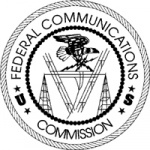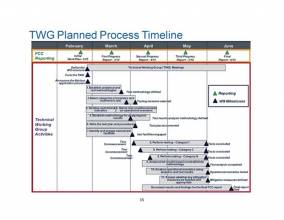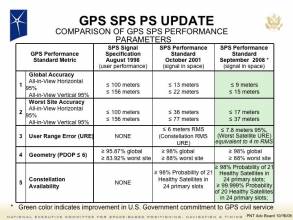In its order allowing Ligado Networks to use satellite frequencies for on-the-ground wireless, the Federal Communications Commission set conditions on the firm’s operations, but only at the very tail end. Those conditions are there to help protect GPS receivers from interference — interference the FCC acknowledges as being quite possible.
The requirements are necessary because the FCC disregarded the established yardstick for protecting GPS in favor of one based on harmful interference. That is, interference that is allowed until it is bad enough that receivers aren’t working right.
In other words: interference is OK up to the point that it isn’t. Once it starts breaking things, you look at how to keep them from breaking.
The globally accepted criterion for protecting GPS has long been a one-decibel (1 dB) degradation of C/N0, the carrier-to-noise power density ratio. This is also called an Interference Protection Criterion or IPC.
This is a way of describing the strength of the GPS signal relative to the surrounding noise. The strength of the GPS signal can naturally vary a bit (the signals come from moving satellites) and the surrounding noise can vary as well. GPS experts use this combined, easy-to-measure criterion to determine how much signal noise you can add and still have receivers work reliably.
Reliability is key. The C/N0 approach includes a bit of margin to allow for the natural fluctuations and challenges that crop up (like heavy tree cover) that impair signal reception. Why? You don’t want an essential or safety-of-life system depending on an unreliable receiver. Positive train control uses GPS to help prevent collisions between moving trains and protect those working alongside the tracks.. There are over 1.5 million drones registered in the United States and GPS-based geofencing automatically keeps them away from airports and collisions with manned aircraft.
GPS is a National Critical Function, according to the Department of Homeland Security, upon which the vast majority of critical infrastructure relies. So, in the same way that civil engineers build in margin to keep drivers safe on a suspension bridge being hit by high winds, spectrum engineers keep people safe by building safety margin into GPS interference measurements.
That margin that will largely disappear under the FCC’ s decision.
It’s What We’ve Done Before
“In determining whether a new service would cause harmful interference to an incumbent service,” the FCC wrote, “we begin with and rely on the Commission’s long-standing definition embodied in our rules: ‘harmful interference’ is ‘[i]nterference which endangers the functioning of a radionavigation service or of other safety services or seriously degrades, obstructs, or repeatedly interrupts a radiocommunication service operating in accordance with [the ITU] Radio Regulations.’ We apply this definition for evaluating potential for interference with respect to all services and allocations, including those associated with RNSS in the 1559-1610 MHz band where GPS operates.”
The FCC weighed the half dozen tests done by the government and Ligado and decided that the “1 dB C/N0 degradation metric does not assess whether the actual performance of the GPS devices is affected and, accordingly, does not directly address whether there would be any ‘harmful interference’ as defined by the Commission.”
That decision is particularly important because GPS receivers simply work—until they don’t.
It is well known, said Logan Scott in a 2016 interview, that GPS receivers can give accurate position information even when experiencing serious interference. Scott is a GPS signal expert and consultant specializing in radio frequency signal processing and waveform design for communications, navigation, and other systems.
As long as GPS receivers are tracking satellites, he said, they can provide fairly accurate positioning information right up to the point where the interference causes them to lose their lock on the satellite. Substituting position error for C/ N0 degradation effectively eliminates the safety margin.
“GPS is very much a safety-of-life system,” said Scott. “Margins are important. You don’t want to use the margin up.”
The 1 dB standard is the “most readily identifiable and predictable metric that will ensure a harmful interference level is prevented,” GPS receiver manufacturer Trimble told the FCC staff in April 16 calls. “It is the only reliable mechanism to ensure the adequate protection of GNSS receivers. Alternative metrics, such as key performance indicators, are administratively impractical given the wide diversity of GNSS receivers and applications, and only reveal problems after harmful interference has already occurred, leaving GPS users with inaccurate or misleading information.”
Conditions
Having chosen to lower the bar, the FCC gave Ligado a list of conditions to help prevent problems. It adopted Ligado’s earlier proposal to not use the spectrum closest to the GPS band for terrestrial service. The FCC is also limiting power in the downlink band from 1526-1536 MHz to 9.8 dBW (10 W) with a +/- 45 degree cross-polarized base station antenna. “Based on FAA analysis, the minimum inter-station separation distance shall be 433 meters in a hexagonal grid,” the FCC wrote. The agency mandated other location limitations and out-of-band emission limits as well as reporting and notice requirements.
Ligado is also required to replace or repair federal government devices “that experience or are likely to experience harmful interference from Ligado’s operations.” To enable this they must have a way to exchange information with the government in place at least 30 days before deploying a base station in the downlink band — the short stretch of useable Ligado spectrum closest to GPS where operations pose the greatest risk.
They have to detail base station locations and technical operating parameters to federal agencies prior to commencing operations in that band and work with affected agencies to identify the devices that could be impacted. They also have to develop a program to repair or replace those devices. If a device can’t be fixed or replaced the firm “shall negotiate with the affected government agency to determine an acceptable received power level over the military installation.”
What About Civil Users?
The situation for civil receivers is unclear. Ligado must maintain a toll-free number for the general public to report interference. The company is not only responsible for taking the calls and investigating the reports, it must inform the FCC of interference within an hour. One has to wonder about this arrangement as that puts both Ligado and the FCC in a difficult position of having to address problems that aren’t supposed to arise.
Ligado also has to give six months notice to the GPS receiver manufacturers, letting them know county by county where base stations will be and updating those coverage maps every six months. This suggests that the receiver manufacturers are to have some role in dealing with interference issues even if it’s just answering questions from their customers. It is not at all clear who pays for any repairs or replacements to receivers that are not owned by the government.
Since Ligado has made clear its intention to deploy its wireless service using existing infrastructure, the firm could begin operations pretty quickly. The FCC, however, said in its order that Ligado could not commence operations for at least 90 days.
So there is some time to consider what comes next. It remains to be seen how well the combination of power limits, advance notice, and corrective mechanisms ordered by the FCC will work to protect GPS.
In fact, the FCC appears to be anticipating some problems.
“Our analysis should not be construed to say that there is no potential for harmful interference to any GPS device currently in operation or in the marketplace,” the FCC wrote. Indeed, the Commission said it acknowledges that even Ligado-backed testing showed “there is potential for harmful interference to some devices, particularly high-precision devices.”
The agency concluded confidently, however, “that the advance notification and other conditions …which build on commitments that Ligado has made with several GPS device manufacturers, will address any identified potential harmful interference to GPS before (ground-based) network operations commence.”
Only time and potentially painful experience will tell.






